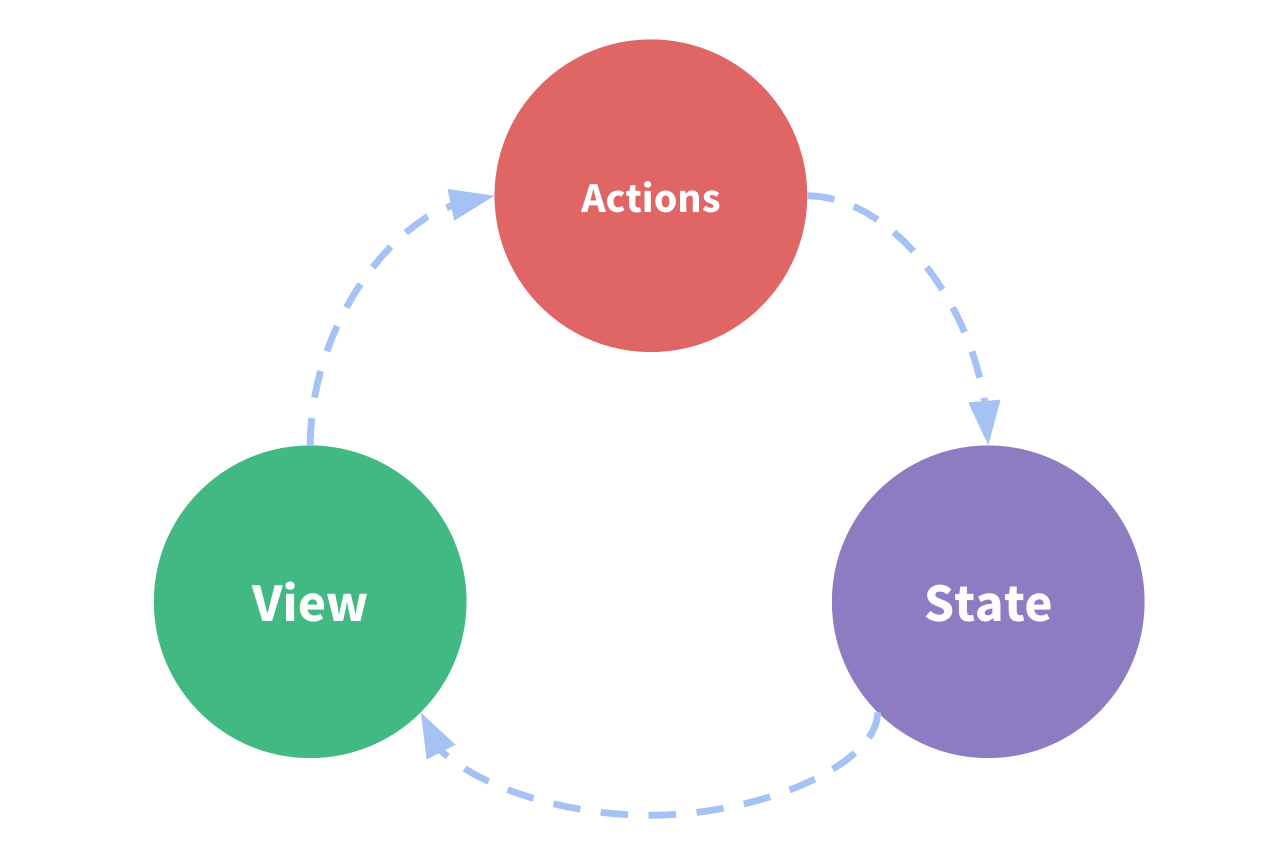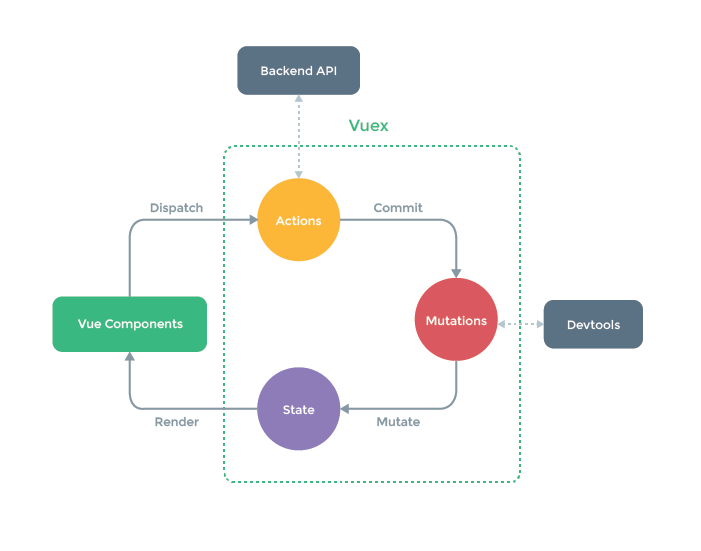[vue] vuex
状态管理模式
new Vue({
// state
data () {
return {
count: 0
}
},
// view
template: `
<div>{{ count }}</div>
`,
// actions
methods: {
increment () {
this.count++
}
}
})
state,驱动应用的数据源;
view,以声明方式将 state 映射到视图;
actions,响应在 view 上的用户输入导致的状态变化。
单向数据流

vuex数据流

State
Vuex 使用单一状态树,用一个对象就包含了全部的应用层级状态。
至此它便作为一个“唯一数据源 (SSOT)”而存在。
每个应用将仅仅包含一个 store 实例。
单一状态树让我们能够直接地定位任一特定的状态片段,在调试的过程中也能轻易地取得整个当前应用状态的快照。
子组件能通过 this.$store 访问到在根实例中注册 store 选项。
const Counter = {
template: `<div>{{ count }}</div>`,
computed: {
count () {
return this.$store.state.count
}
}
}
放在computed里,也可以和组件内混合
computed: {
localComputed () { /* ... */ },
// 使用对象展开运算符将此对象混入到外部对象中
...mapState({
// ...
})
}
mapState 辅助函数
在组件内可以使用this.$store.state.xx获取state,也可以通过mapState 辅助函数
// 在单独构建的版本中辅助函数为 Vuex.mapState
import { mapState } from 'vuex'
export default {
// ...
computed: mapState({
// 箭头函数可使代码更简练
count: state => state.count,
// 传字符串参数 'count' 等同于 `state => state.count`
countAlias: 'count',
// 为了能够使用 `this` 获取局部状态,必须使用常规函数
countPlusLocalState (state) {
return state.count + this.localCount
}
})
}
Getter
有时候需要从 store 中的 state 中派生出一些状态.
const store = new Vuex.Store({
state: {
todos: [
{ id: 1, text: '...', done: true },
{ id: 2, text: '...', done: false }
]
},
getters: {
doneTodos: state => {
return state.todos.filter(todo => todo.done)
}
}
})
//Getter 会暴露为 store.getters 对象
store.getters.doneTodos // -> [{ id: 1, text: '...', done: true }]
//Getter 也可以接受其他 getter 作为第二个参数:
getters: {
// ...
doneTodosCount: (state, getters) => {
return getters.doneTodos.length
}
}
store.getters.doneTodosCount // -> 1
//可以很容易地在任何组件中使用它:
computed: {
doneTodosCount () {
return this.$store.getters.doneTodosCount
}
}
//也可以通过让 getter 返回一个函数,来实现给 getter 传参。在你对 store 里的数组进行查询时非常有用。
getters: {
// ...
getTodoById: (state) => (id) => {
return state.todos.find(todo => todo.id === id)
}
}
store.getters.getTodoById(2) // -> { id: 2, text: '...', done: false }
mapGetters 辅助函数
在组件内可以通过this.$store.getters.xx获取派生数据,也可以通过mapGetters 辅助函数。
import { mapGetters } from 'vuex'
export default {
// ...
computed: {
// 使用对象展开运算符将 getter 混入 computed 对象中
...mapGetters([
'doneTodosCount',
'anotherGetter'
]),
// 映射 `this.doneCount` 为 `store.getters.doneTodosCount`
...mapGetters({
doneCount: 'doneTodosCount'
})
}
}
Mutation
更改 Vuex 的 store 中的状态的唯一方法是提交 mutation。
Vuex 中的 mutation 非常类似于事件:
每个 mutation 都有一个字符串的 事件类型 (type) 和 一个 回调函数 (handler)。
这个回调函数就是实际进行状态更改的地方,并且它会接受 state 作为第一个参数.
const store = new Vuex.Store({
state: {
count: 1
},
mutations: {
increment (state) {
// 变更状态
state.count++
}
}
})
//不能直接调用一个 mutation handler。
//而是这样用
store.commit('increment')
以向 store.commit 传入额外的参数,即 mutation 的 载荷(payload)
mutations: {
increment (state, n) {
state.count += n
}
}
store.commit('increment', 10)
大多数情况下,载荷应该是一个对象,这样可以包含多个字段并且记录的 mutation 会更易读:
// ...
mutations: {
increment (state, payload) {
state.count += payload.amount
}
}
store.commit('increment', {
amount: 10
})
提交 mutation 的另一种方式是直接使用包含 type 属性的对象.
当使用对象风格的提交方式,整个对象都作为载荷传给 mutation 函数,因此 handler 保持不变.
store.commit({
type: 'increment',
amount: 10
})
mutations: {
increment (state, payload) {
state.count += payload.amount
}
}
可以使用常量替代 Mutation 事件类型
Mutation 必须是同步函数
Mutation 需遵守 Vue 的响应规则
Vuex 的 store 中的状态是响应式的,当变更状态时,监视状态的 Vue 组件也会自动更新。
这也意味着 Vuex 中的 mutation 也需要与使用 Vue 一样遵守一些注意事项:
- 最好提前在你的 store 中初始化好所有所需属性。
- 当需要在对象上添加新属性时,你应该
使用Vue.set(obj, 'newProp', 123),
或者
以新对象替换老对象state.obj = { ...state.obj, newProp: 123 }
mapMutations 辅助函数
可以在组件中使用 this.$store.commit('xxx') 提交 mutation,或者使用 mapMutations 辅助函数将组件中的 methods 映射为 store.commit 调用(需要在根节点注入 store)。
import { mapMutations } from 'vuex'
export default {
// ...
methods: {
...mapMutations([
'increment', // 将 `this.increment()` 映射为 `this.$store.commit('increment')`
// `mapMutations` 也支持载荷:
'incrementBy' // 将 `this.incrementBy(amount)` 映射为 `this.$store.commit('incrementBy', amount)`
]),
...mapMutations({
add: 'increment' // 将 `this.add()` 映射为 `this.$store.commit('increment')`
})
}
}
Action
Action 类似于 mutation,不同在于:
- Action 提交的是 mutation,而不是直接变更状态。
- Action 可以包含任意异步操作。
一个简单的 action:
const store = new Vuex.Store({
state: {
count: 0
},
mutations: {
increment (state) {
state.count++
}
},
actions: {
increment (context) {
context.commit('increment')
}
}
//这样写更简单
actions: {
increment ({ commit }) {
commit('increment')
}
}
})
Action 函数接受一个与 store 实例具有相同方法和属性的 context 对象,因此你可以调用 context.commit 提交一个 mutation,或者通过 context.state 和 context.getters 来获取 state 和 getters。
Action 通过 store.dispatch 方法触发:
store.dispatch('increment')
可以在 action 内部执行异步操作:
actions: {
incrementAsync ({ commit }) {
setTimeout(() => {
commit('increment')
}, 1000)
}
}
Actions 支持同样的载荷方式和对象方式进行分发:
// 以载荷形式分发
store.dispatch('incrementAsync', {
amount: 10
})
// 以对象形式分发
store.dispatch({
type: 'incrementAsync',
amount: 10
})
一个购物车示例
actions: {
checkout ({ commit, state }, products) {
// 把当前购物车的物品备份起来
const savedCartItems = [...state.cart.added]
// 发出结账请求,然后乐观地清空购物车
commit(types.CHECKOUT_REQUEST)
// 购物 API 接受一个成功回调和一个失败回调
shop.buyProducts(
products,
// 成功操作
() => commit(types.CHECKOUT_SUCCESS),
// 失败操作
() => commit(types.CHECKOUT_FAILURE, savedCartItems)
)
}
}
组合 Action
// 假设 getData() 和 getOtherData() 返回的是 Promise
actions: {
async actionA ({ commit }) {
commit('gotData', await getData())
},
async actionB ({ dispatch, commit }) {
await dispatch('actionA') // 等待 actionA 完成
commit('gotOtherData', await getOtherData())
}
}
mapActions 辅助函数
你在组件中使用 this.$store.dispatch('xxx') 分发 action,或者使用 mapActions 辅助函数将组件的 methods 映射为 store.dispatch 调用(需要先在根节点注入 store)
import { mapActions } from 'vuex'
export default {
// ...
methods: {
...mapActions([
'increment', // 将 `this.increment()` 映射为 `this.$store.dispatch('increment')`
// `mapActions` 也支持载荷:
'incrementBy' // 将 `this.incrementBy(amount)` 映射为 `this.$store.dispatch('incrementBy', amount)`
]),
...mapActions({
add: 'increment' // 将 `this.add()` 映射为 `this.$store.dispatch('increment')`
})
}
}
Module
由于使用单一状态树,应用的所有状态会集中到一个比较大的对象。
当应用变得非常复杂时,store 对象就有可能变得相当臃肿。
为了解决以上问题,Vuex 允许将 store 分割成模块(module)。
每个模块拥有自己的 state、mutation、action、getter、甚至是嵌套子模块——从上至下进行同样方式的分割:
const moduleA = {
state: { ... },
mutations: { ... },
actions: { ... },
getters: { ... }
}
const moduleB = {
state: { ... },
mutations: { ... },
actions: { ... }
}
const store = new Vuex.Store({
modules: {
a: moduleA,
b: moduleB
}
})
store.state.a // -> moduleA 的状态
store.state.b // -> moduleB 的状态
模块的局部状态
const moduleA = {
//模块内部的 mutation 和 getter,接收的第一个参数是模块的局部状态对象:
state: { count: 0 },
mutations: {
increment (state) {
// 这里的 `state` 对象是模块的局部状态
state.count++
}
},
//对于模块内部的 action,局部状态通过 context.state 暴露出来,根节点状态则为 context.rootState:
actions: {
incrementIfOddOnRootSum ({ state, commit, rootState }) {
if ((state.count + rootState.count) % 2 === 1) {
commit('increment')
}
}
}
//对于模块内部的 getter,根节点状态会作为第三个参数暴露出来:
getters: {
sumWithRootCount (state, getters, rootState) {
return state.count + rootState.count
}
}
}
命名空间
默认情况下,模块内部的 action、mutation 和 getter 是注册在全局命名空间的,这样使得多个模块能够对同一 mutation 或 action 作出响应。
如果希望模块具有更高的封装度和复用性,可以通过添加 namespaced: true 的方式使其成为命名空间模块。
当模块被注册后,它的所有 getter、action 及 mutation 都会自动根据模块注册的路径调整命名。
启用了命名空间的 getter 和 action 会收到局部化的 getter,dispatch 和 commit。
换言之,在使用模块内容(module assets)时不需要在同一模块内额外添加空间名前缀。
更改 namespaced 属性后不需要修改模块内的代码。
const store = new Vuex.Store({
modules: {
account: {
namespaced: true,
// 模块内容(module assets)
state: { ... }, // 模块内的状态已经是嵌套的了,使用 `namespaced` 属性不会对其产生影响
getters: {
isAdmin () { ... } // -> getters['account/isAdmin']
},
actions: {
login () { ... } // -> dispatch('account/login')
},
mutations: {
login () { ... } // -> commit('account/login')
},
// 嵌套模块
modules: {
// 继承父模块的命名空间
myPage: {
state: { ... },
getters: {
profile () { ... } // -> getters['account/profile']
}
},
// 进一步嵌套命名空间
posts: {
namespaced: true,
state: { ... },
getters: {
popular () { ... } // -> getters['account/posts/popular']
}
}
}
}
}
})
如果希望使用全局 state 和 getter,rootState 和 rootGetter 会作为第三和第四参数传入 getter,也会通过 context 对象的属性传入 action。
若需要在全局命名空间内分发 action 或提交 mutation,将 { root: true } 作为第三参数传给 dispatch 或 commit 即可。
modules: {
foo: {
namespaced: true,
getters: {
// 在这个模块的 getter 中,`getters` 被局部化了
// 你可以使用 getter 的第四个参数来调用 `rootGetters`
someGetter (state, getters, rootState, rootGetters) {
getters.someOtherGetter // -> 'foo/someOtherGetter'
rootGetters.someOtherGetter // -> 'someOtherGetter'
},
someOtherGetter: state => { ... }
},
actions: {
// 在这个模块中, dispatch 和 commit 也被局部化了
// 他们可以接受 `root` 属性以访问根 dispatch 或 commit
someAction ({ dispatch, commit, getters, rootGetters }) {
getters.someGetter // -> 'foo/someGetter'
rootGetters.someGetter // -> 'someGetter'
dispatch('someOtherAction') // -> 'foo/someOtherAction'
dispatch('someOtherAction', null, { root: true }) // -> 'someOtherAction'
commit('someMutation') // -> 'foo/someMutation'
commit('someMutation', null, { root: true }) // -> 'someMutation'
},
someOtherAction (ctx, payload) { ... }
}
}
}
当使用 mapState, mapGetters, mapActions 和 mapMutations 这些函数来绑定命名空间模块时,写起来可能比较繁琐。
可以将模块的空间名称字符串作为第一个参数传递给上述函数,这样所有绑定都会自动将该模块作为上下文。
computed: {
...mapState({
a: state => state.some.nested.module.a,
b: state => state.some.nested.module.b
})
},
methods: {
...mapActions([
'some/nested/module/foo',
'some/nested/module/bar'
])
}
//优化
computed: {
...mapState('some/nested/module', {
a: state => state.a,
b: state => state.b
})
},
methods: {
...mapActions('some/nested/module', [
'foo',
'bar'
])
}
可以通过使用 createNamespacedHelpers 创建基于某个命名空间辅助函数。它返回一个对象,对象里有新的绑定在给定命名空间值上的组件绑定辅助函数
import { createNamespacedHelpers } from 'vuex'
const { mapState, mapActions } = createNamespacedHelpers('some/nested/module')
export default {
computed: {
// 在 `some/nested/module` 中查找
...mapState({
a: state => state.a,
b: state => state.b
})
},
methods: {
// 在 `some/nested/module` 中查找
...mapActions([
'foo',
'bar'
])
}
}
模块动态注册
在 store 创建之后,可以使用 store.registerModule 方法注册模块.
之后就可以通过 store.state.myModule 和 store.state.nested.myModule 访问模块的状态。
模块动态注册功能使得其他 Vue 插件可以通过在 store 中附加新模块的方式来使用 Vuex 管理状态。
// 注册模块 `myModule`
store.registerModule('myModule', {
// ...
})
// 注册嵌套模块 `nested/myModule`
store.registerModule(['nested', 'myModule'], {
// ...
})
也可以使用 store.unregisterModule(moduleName) 来动态卸载模块。
但不能使用此方法卸载静态模块(即创建 store 时声明的模块)。
在注册一个新 module 时,想保留过去的 state,例如从一个服务端渲染的应用保留 state。
可以通过 preserveState 选项将其归档:store.registerModule('a', module, { preserveState: true })。
模块重用
有时可能需要创建一个模块的多个实例,例如:
- 创建多个 store,他们公用同一个模块 (例如当 runInNewContext 选项是 false 或 'once' 时,为了在服务端渲染中避免有状态的单例)
- 在一个 store 中多次注册同一个模块
如果使用一个纯对象来声明模块的状态,那么这个状态对象会通过引用被共享,导致状态对象被修改时 store 或模块间数据互相污染的问题。
实际上这和 Vue 组件内的 data 是同样的问题。因此解决办法也是相同的,
使用一个函数来声明模块状态:
const MyReusableModule = {
state () {
return {
foo: 'bar'
}
},
// mutation, action 和 getter 等等...
}
项目结构
Vuex 并不限制代码结构。
但是,它规定了一些需要遵守的规则:
- 应用层级的状态应该集中到单个 store 对象中。
- 提交 mutation 是更改状态的唯一方法,并且这个过程是同步的。
- 异步逻辑都应该封装到 action 里面。
推荐的项目结构
├── index.html
├── main.js
├── api
│ └── ... # 抽取出API请求
├── components
│ ├── App.vue
│ └── ...
└── store
├── index.js # 我们组装模块并导出 store 的地方
├── actions.js # 根级别的 action
├── mutations.js # 根级别的 mutation
└── modules
├── cart.js # 购物车模块
└── products.js # 产品模块
严格模式
开启严格模式,仅需在创建 store 的时候传入 strict: true。
在严格模式下,无论何时发生了状态变更且不是由 mutation 函数引起的,将会抛出错误。这能保证所有的状态变更都能被调试工具跟踪到。
但是不要在发布环境下启用严格模式。严格模式会深度监测状态树来检测不合规的状态变更,确保在发布环境下关闭严格模式,以避免性能损失。
const store = new Vuex.Store({
// ...
strict: process.env.NODE_ENV !== 'production'
})
热重载
使用 webpack 的 Hot Module Replacement API,Vuex 支持在开发过程中热重载 mutation、module、action 和 getter。
对于 mutation 和模块,需要使用 store.hotUpdate() 方法.
// store.js
import Vue from 'vue'
import Vuex from 'vuex'
import mutations from './mutations'
import moduleA from './modules/a'
Vue.use(Vuex)
const state = { ... }
const store = new Vuex.Store({
state,
mutations,
modules: {
a: moduleA
}
})
if (module.hot) {
// 使 action 和 mutation 成为可热重载模块
module.hot.accept(['./mutations', './modules/a'], () => {
// 获取更新后的模块
// 因为 babel 6 的模块编译格式问题,这里需要加上 `.default`
const newMutations = require('./mutations').default
const newModuleA = require('./modules/a').default
// 加载新模块
store.hotUpdate({
mutations: newMutations,
modules: {
a: newModuleA
}
})
})
}


